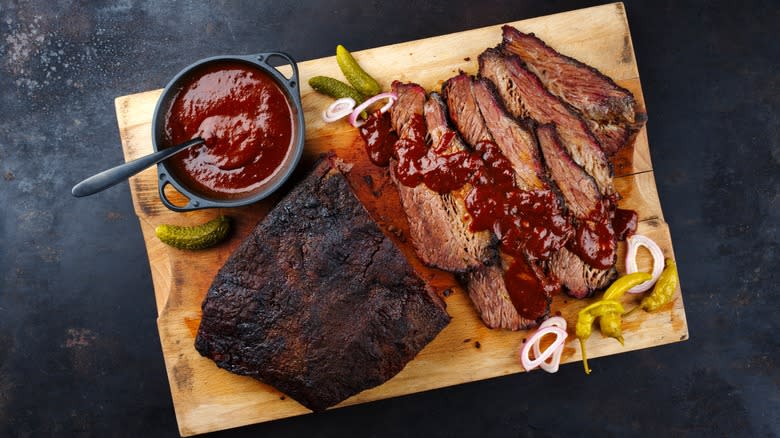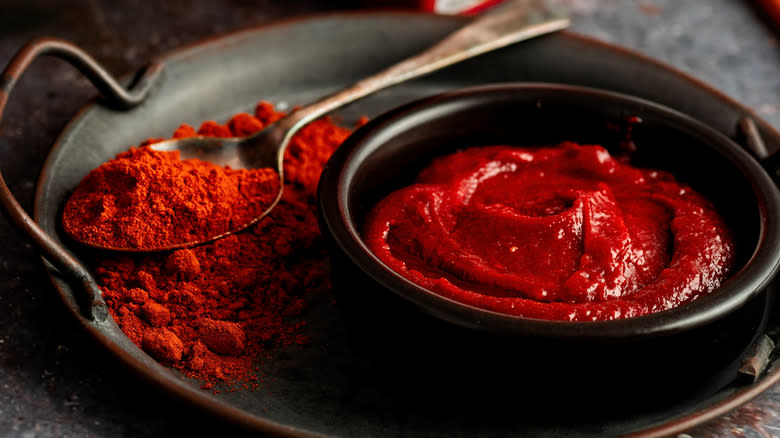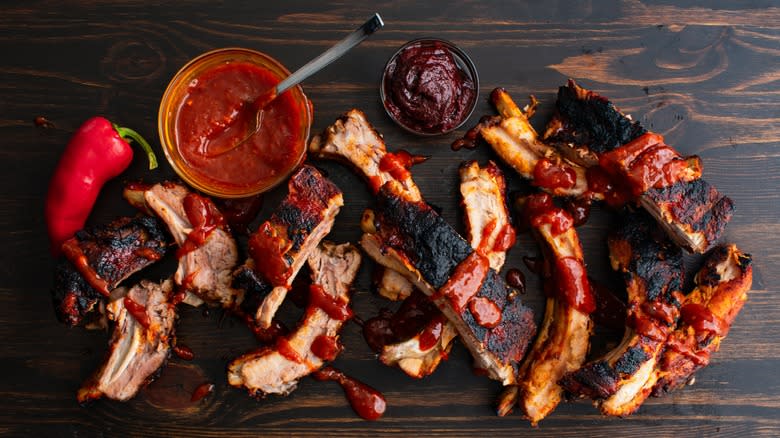Give Brisket Some Korean-Style Flair With This Spicy Binder

A key part of making delicious Texas-style brisket is the spice rub you apply before you smoke it low and slow. However, there isn't always enough fat or moisture on the brisket for the spice rub to stay on. In these cases, you use a wet ingredient called a binder to help the seasonings stick to the meat and form Texas-style brisket's signature bark. You can use many ingredients as a brisket binder, including mayonnaise or barbeque sauce. Or, you can broaden your horizons and use gochujang to give your next brisket some Korean flair.
Gochujang is a simple red chili paste made primarily from gochugaru, or ground Korean chili peppers. Its list of ingredients is short so it doesn't overtake your usual spice rub, plus gochujang's mild heat, light smoky flavor, and subtle notes of sweetness and umami are already associated with brisket.
Read more: The Unexpected Meat You Need To Avoid Grilling At All Costs
Why Gochujang Is The Perfect Binder

Gochujang is the perfect brisket rub binder because its flavors are a natural match with brisket, so it's not a shock to the taste buds when you dig in. First, gochugaru's smokiness compliments the smoke from brisket's cooking process. Then, gochugaru's heat starts to bloom, heat you'd otherwise get from cayenne or chili powder. Its heat is subtler than crushed red pepper flakes, so it won't overwhelm. Adding this smoky, subtle heat to brisket is like taking a bite of baechu kimchi with Korean BBQ, because gochugaru is one of kimchi's key ingredients.
Gochujang also packs sweetness and umami that can make brisket sing. Sweetness, which usually comes from brown sugar in spice rubs, instead comes from the fermentation process of making gochujang. It's boosted as the heat caramelizes the sugars while cooking. The umami rich fermented soybeans in gochujang (a key ingredient in miso) boosts the natural umami present in beef. Using gochujang makes flavoring your brisket easier, since you can dial back redundant spices and seasonings from your rub.
When applying gochujang, start with just enough to thinly cover your brisket because its flavor is strong. Since it's tacky like tomato paste, use your hands to get the best application -- the tackiness also makes it cling to brisket better. Gochujang's deep red color can make the bark look darker than usual once the brisket is done.
Other Foods To Enjoy With Gochujang

Because of gochujang's heat and smokiness, it's great to use on anything that goes on your grill. Stir some up with mayo and slather it on Asian-inspired sliders, or toss some smoked chicken wings in a Korean BBQ-inspired sauce. You could also use it as an ingredient to upgrade salmon, add it to a glaze for grilled eggplant, or mix it into a baste for spicy Brussels sprouts and tofu.
You can also use gochujang straight, with no alteration. Adding a dab to a slice of Korean BBQ pork belly fresh off the grill is a quick trip to heaven. Just be careful to not use too much because of its powerful flavor when eaten raw.
You're not stuck using it only with grilled and smoked foods either. Try mixing some into candy apple coating for a kind of Korean chamoy, or add a splash to mac and cheese for a kick. It's a perfect ingredient for soups too, especially soups that caramelize tomato paste since you can caramelize both in the same step. It also makes a perfect substitute for Louisiana-style hot sauce and sriracha. When replacing Louisiana-style sauces, you lose the harshness of the vinegar and gain some sweetness. Replacing sriracha with gochujang adds hints of sweetness and umami that sriracha lacks.
Read the original article on The Daily Meal.


